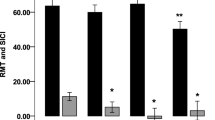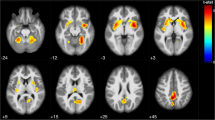Abstract
Background
The pathogenesis of cognitive deficits in multiple sclerosis (MS) patients is the subject of debate. A causative role of grey matter impairment has been suggested. Acetylcholinesterase inhibitors have been proposed in the treatment of cognitive impairment in MS. Short-latency afferent inhibition (SAI) is a cortical phenomenon assessed by a transcranial magnetic stimulation protocol that provides an in vivo index of central cholinergic function.
Methods
We recruited 20 consecutive relapsing-remitting or secondary progressive MS patients showing normal upper limb somatosensory and motor evoked potentials. SAI of the left-hand motor cortex from median nerve stimuli was tested. A matched group of 20 healthy subjects was also assessed. All patients underwent neuropsychological assessment with Rao’s Brief Repeatable Battery (BRB). Multiple regression was performed on the number of failed tests and on scores of single BRB tests as dependent variables with Extended Disability Status Scale (EDSS) score, SAI, age, gender and disease duration as regressors. Patients with impaired SAI, were reassessed after a single oral dose of rivastigmine.
Results
SAI was a significant predictor of the score in tests that assess verbal memory. EDSS score and age were found as predictors of the other BRB tests. SAI was significantly improved by oral rivastigmine.
Conclusions
Our data confirm that cognitive impairment in MS is multifactorial. The performances in the subdomain of verbal memory are predicted by SAI. These results favour the hypothesis of grey matter involvement and suggest a role of acetylcholine dysfunction in the pathogenesis of some aspects of cognitive deficits in MS.
Similar content being viewed by others
References
Amato MP, Portaccio E, Goretti B, et al. (2006) The Rao’s Brief Repeatable attery and Stroop Test: normative values with age, education and gender corrections in an Italian population. Mult Scler 12:787–793
Bobholz JA, Rao SM (2003) Cognitive dysfunction in multiple sclerosis: a review of recent developments. Curr Opin Neurol 16:283–288
Amato MP, Bartolozzi ML, Zipoli V, et al. (2004) Neocortical volume decrease in relapsing-remitting MS patients with mild cognitive impairment. Neurology 63:89–93
Benedict RH, Zivadinov R, Carone DA, et al. (2005) Regional lobar atrophy predicts memory impairment in multiple sclerosis. AJNR Am J Neuroradiol 26:1824–1831
Tekok-Kilic A, Benedict RH, Weinstock- Guttman B, et al. (2007) Independent contributions of cortical gray matter atrophy and ventricle enlargement for predicting neuropsychological impairment in multiple sclerosis. Neuroimage 36:1294–1300
Filippi M, Tortorella C, Rovaris M, et al. (2000) Changes in the normal appearing brain tissue and cognitive impairment in multiple sclerosis. J Neurol Neurosurg Psychiatry 68:157–161
Houtchens MK, Benedict RH, Killiany R, et al. (2007) Thalamic atrophy and cognition in multiple sclerosis. Neurology 69:1213–1223
Pirko I, Lucchinetti CF, Sriram S, et al. (2007) Gray matter involvement in multiple sclerosis. Neurology 68:634–642
Sanfilipo MP, Benedict RH, Weinstock- Guttman B, et al. (2006) Gray and white matter brain atrophy and neuropsychological impairment in multiple sclerosis. Neurology 66:685–692
Blinkenberg M, Rune K, Jensen CV, et al. (2000) Cortical cerebral metabolism correlates with MRI lesion load and cognitive dysfunction in MS. Neurology 54:558–564
Krupp LB, Christodoulou C, Melville P, et al. (2004) Donepezil improved memory in multiple sclerosis in a randomized clinical trial. Neurology 63:1579–1585
Porcel J, Montalban X (2006) Anticholinesterasics in the treatment of cognitive impairment in multiple sclerosis. J Neurol Sci 245:177–181
Parry AM, Scott RB, Palace J, et al. (2003) Potentially adaptive functional changes in cognitive processing for patients with multiple sclerosis and their acute modulation by rivastigmine. Brain 126:2750–2760
D’Intino G, Paradisi M, Fernandez M, et al. (2005) Cognitive deficit associated with cholinergic and nerve growth factor down-regulation in experimental allergic encephalomyelitis in rats. Proc Natl Acad Sci USA 102:3070–3075
Ruberg M, Villageois A, Bonnet AM, et al. (1987) Acetylcholinesterase and butyrylcholinesterase activity in the cerebrospinal fluid of patients with neurodegenerative diseases involving cholinergic systems. J Neurol Neurosurg Psychiatry 50:538–543
Tokimura H, Di Lazzaro V, Tokimura Y, et al. (2000) Short latency inhibition of human hand motor cortex by somatosensory input from the hand. J Physiol 523(Pt 2):503–513
Di Lazzaro V, Oliviero A, Profice P, et al. (2000) Muscarinic receptor blockade has differential effects on the excitability of intracortical circuits in the human motor cortex. Exp Brain Res 135:455–461
Di Lazzaro V, Oliviero A, Tonali PA, et al. (2002) Noninvasive in vivo assessment of cholinergic cortical circuits in AD using transcranial magnetic stimulation. Neurology 59:392–397
Di Lazzaro V, Oliviero A, Pilato F, et al. (2005) Neurophysiological predictors of long term response to AChE inhibitors in AD patients. J Neurol Neurosurg Psychiatry 76:1064–1069
Polman CH, Reingold SC, Edan G, et al. (2005) Diagnostic criteria for multiple sclerosis: 2005 revisions to the “McDonald Criteria”. Ann Neurol 58:840–846
Kurtzke JF (1983) Rating neurologic impairment in multiple sclerosis: an expanded disability status scale (EDSS). Neurology 33:1444–1452
Beck AT (1993) Beck Depression Inventory. San Antonio, TX: Psychological Corporation
Di Lazzaro V, Pilato F, Dileone M, et al. (2005) Dissociated effects of diazepam and lorazepam on short-latency afferent inhibition. J Physiol 569:315–323
Rossini PM, Barker AT, Berardelli A, et al. (1994) Non-invasive electrical and magnetic stimulation of the brain, spinal cord and roots: basic principles and procedures for routine clinical application. Report of an IFCN committee. Electroencephalogr Clin Neurophysiol 91:79–92
Di Lazzaro V, Pilato F, Dileone M, et al. (2007) Functional evaluation of cerebral cortex in dementia with Lewy bodies. Neuroimage 37:422–429
Rao SM (1990) Cognitive Function Study Group of the National Multiple Sclerosis Society. A manual for the Brief Repeatable Battery of neuropsychological tests in Multiple Sclerosis. Milwaukee, WI: Medical College of Wisconsin
Solari A, Mancuso L, Motta A, et al. (2002) Comparison of two brief neuropsychological batteries in people with multiple sclerosis. Mult Scler 8:169–176
Kennedy JS, Polinsky RJ, Johnson B, et al. (1999) Preferential cerebrospinal fluid acetylcholinesterase inhibition by rivastigmine in humans. J Clin Psychopharmacol 19:513–521
Oliviero A, Leon AM, Holler I, et al. (2005) Reduced sensorimotor inhibition in the ipsilesional motor cortex in a patient with chronic stroke of the paramedian thalamus. Clin Neurophysiol 116:2592–2598
Deloire MS, Bonnet MC, Salort E, et al. (2006) How to detect cognitive dysfunction at early stages of multiple sclerosis? Mult Scler 12:445–452
Rao SM, Leo GJ, Bernardin L, et al. (1991) Cognitive dysfunction in multiple sclerosis. I. Frequency, patterns, and prediction. Neurology 41:685–691
Evangelou N, Esiri MM, Smith S, et al. (2000) Quantitative pathological evidence for axonal loss in normal appearing white matter in multiple sclerosis. Ann Neurol 47:391–395
Trapp BD, Peterson J, Ransohoff RM, et al. (1998) Axonal transection in the lesions of multiple sclerosis. N Engl J Med 338:278–285
Smith KJ, McDonald WI (1999) The pathophysiology of multiple sclerosis: the mechanisms underlying the production of symptoms and the natural history of the disease. Philos Trans R Soc Lond B Biol Sci 354:1649–1673
Amato MP, Portaccio E, Goretti B, et al. (2007) Association of neocortical volume changes with cognitive deterioration in relapsing-remitting multiple sclerosis. Arch Neurol 64:1157–1161
Lockwood AH, Linn RT, Szymanski H, et al. (2004) Mapping the neural systems that mediate the Paced Auditory Serial Addition Task (PASAT). J Int Neuropsychol Soc 10:26–34
Di Lazzaro V, Pilato F, Dileone M, et al. (2007) Segregating two inhibitory circuits in human motor cortex at the level of GABAA receptor subtypes: a TMS study. Clin Neurophysiol 118:2207–2214
Mesulam M, Siddique T, Cohen B (2003) Cholinergic denervation in a pure multi-infarct state: observations on CADASIL. Neurology 60:1183–1185
Paulesu E, Perani D, Fazio F, et al. (1996) Functional basis of memory impairment in multiple sclerosis: a [18F]FDG PET study. Neuroimage 4:87–96
Pozzilli C, Passafiume D, Bernardi S, et al. (1991) SPECT, MRI and cognitive functions in multiple sclerosis. J Neurol Neurosurg Psychiatry 54:110–115
Hasselmo ME (2006) The role of acetylcholine in learning and memory. Curr Opin Neurobiol 16:710–715
Bonfiglio L, Rossi B, Sartucci F (2006) Prolonged intracortical delay of longlatency reflexes: electrophysiological evidence for a cortical dysfunction in multiple sclerosis. Brain Res Bull 69:606–613
Caramia MD, Palmieri MG, Desiato MT, et al. (2004) Brain excitability changes in the relapsing and remitting phases of multiple sclerosis: a study with transcranial magnetic stimulation. Clin Neurophysiol 115:956–965
Author information
Authors and Affiliations
Corresponding author
Rights and permissions
About this article
Cite this article
Cucurachi, L., Immovilli, P., Granella, F. et al. Short-latency afferent inhibition predicts verbal memory performance in patients with multiple sclerosis. J Neurol 255, 1949–1956 (2008). https://doi.org/10.1007/s00415-008-0041-5
Received:
Revised:
Accepted:
Published:
Issue Date:
DOI: https://doi.org/10.1007/s00415-008-0041-5




